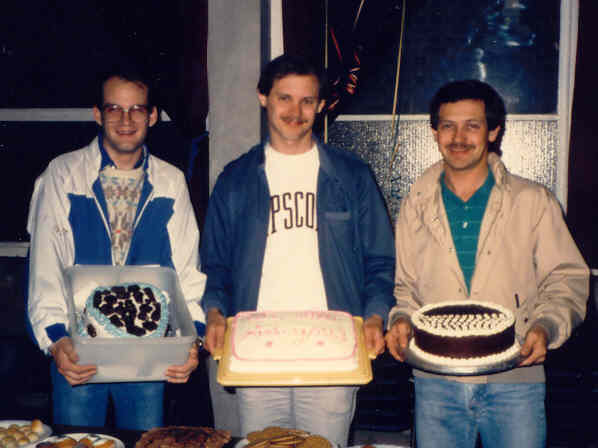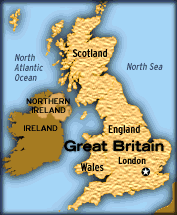About a month after graduating from university in 1986, Gene,
Randall and I flew to London to live for two years. We were members of Project Good News at
university, a missions training program, which prepared us for the work we were going to be doing
in south London--youth work and church work. Gene was a psychology major, and grew up in NW
Georgia. Randall was a chemistry major, and grew up in Middle Tennessee. I was a speech major, and
grew up primarily in the Mid-West. We had three very different personalities, but we were
quite similar in matters of faith and attitude. Gene was the leader, and had the most humorous
personality and charisma. Randall and I were more serious, yet personable, and had unique talents
that rounded us out as a team.
For the first three weeks in London, we lived in an old flat above and behind an antique
shop in Thornton Heath at the corner of Brigstock Road and Boswell Road
(see map). The entrance to the flat was on Boswell, which was
a side-street. It was a two-story flat, with a tiny kitchen in the back. The bathroom upstairs, was generous
in size, but did not have a shower. The toilet, had a water tank way-up near the ceiling, and a
long pull-chain to make it flush. Each of us had a bedroom, and mine was the largest. My
bedroom overlooked the high street (which was noisy), and at night, the flashing light from
the zebra-crossing shined through the curtains. I'll always remember that. Our first purchase
together was a second-hand TV and VCR. It was in Thornton Heath that we first learned to shop for
groceries at Tesco, Bejams', and the like; eat out at British fast food establishments; ride
buses, and walk around the streets to orient ourselves, which basically, provided a lot of our
earlier entertainment in London. The flat had been left vacant by missionaries who had
previously worked in south London. We had the choice of staying there, or finding somewhere
else to live. It was cheap, however, this was way too far south of the area that we were going
to be working in, so we looked for a flat to rent that was closer to the New Cross-Lewisham
area, about six or seven miles NE. Fortunately, there was a flat that was just newly remodeled
on Telegraph Hill, in New Cross, that looked and felt just right for us, so we moved.
New Cross (see map) is located in SE London, about fifteen
minutes from London Bridge station by train. OK, New Cross may not be one of the most
illustrious parts of London, but for
two years it was our home. To many drivers, it is just a bend in the road on the outskirts
of inner south London, on the way to London's sprawling suburbia, but it does have some
quaint old neighborhoods that date back to the 1820s, and interesting history (most of which,
I have forgotten!) Being on Telegraph Hill, our flat was a half-mile from shops, banks, and the
New Cross Gate train & tube station. There was a boys and girls prep school nearby called
Haberdasher-Asks School. The boys met on top of the hill, and the girls met at the bottom, so
we were used to seeing school kids strolling around in their uniforms a lot. At the top of our
street there was a red phone box, and a five-way roundabout, but two of the streets were
one-way, to residentialize the traffic flow. Bus service going to Peckham, to the west, came by
every half-hour, or so. Our neighborhood was a safe, even somewhat pastoral place to live, and
still feel close enough to hurry up to West, or central London in less than, say, forty-five
minutes. We lived just one house from the top of Jerningham Road, facing westerly. The street
was lined with sycamore trees, and the houses were all brick turn-of-the-century Victorian,
with a Church of England located on the other side of the roundabout from us. There were two
parks on Telegraph Hill that provided foot paths, and greenery. The lower park had a pitch where
we tried to teach some local kids how to play American football, and the upper park provided
one of the best vistas of central London that one could find. Absolutely! You could see the
Battersea power station way-off in the west, Parliament, Big Ben, and St. Paul's dome all the way
to the Eastend of London. There were also tennis courts, and a small library in the community
center next to the park.
| The "Three Lads," Randall Nelson, me and Gene Fletcher. |

|
Gene, Randall and I worked together for the South Bermondsey Church of Christ, located
about a mile and a half north of the flat. Our flat became quite a den of activity. We
constantly had company at the flat. Eating, entertaining, playing games, watching videos,
conducting informal meetings, devotionals, and travelers stopping over, were the norm. The
three of us shared all the utility bills, domestic chores, took turns cooking,
washed and dried all our own clothes etc., and always kept the place tidy for visitors. Even
our congenial Ghanaian landlord named Fred--who stopped by frequently--always had a
smile on his face because he thought we were great tenants. We got to know some of our
neighbors--there were many--and generally, didn't have any problems living and getting
along.
Our flat was newly remodeled and furnished, so it was quite modern on the inside. The
outside looked the same as it did when it was built in about 1905, except for the cement yard
in front. There was a side entrance to our flat, which was probably added at some point. It
only had two bedrooms, so Randall and I ended up sharing the larger one, which worked out all
right (we had a good view of the street through a large bay window), and
Gene took the smaller bedroom. Each of us bought a small desk to use for study, and we bought
a second-hand stereo together for the living room. We had a fairly large kitchen, by London
standards, with a washing machine and an upright refrigerator (we bought our own dryer). The
hot water pressure was a bit disappointing much of the time, being on a hill, but we learned
to accept that. The only other thing that we found annoying was the noise from the upstairs
neighbors, who were young folks like us, and at times a bit loud. Houses typically were divided
into separate flats, so the thickness of walls and floors were not always an adequate barrier,
but we still got along well with them. We had access to a church van, which we parked in front
of the flat most of the time that was used for church activities and for buying groceries,
etc., and I bought a used motorcycle (a Honda CD125) for personal use.
One extraordinary thing that happened while we lived in the flat was the storm of October
16, 1987. Some called it the "storm of the century," or even worse! (The BBC credits it
as being the fourth most severe storm since records began, but still not officially classified
as a hurricane.) Early that morning at about 2:00 a.m., I woke in my bed to very loud
hurricane-force winds against the window that struck London without advanced warning
from weather forecasters. The brunt of the storm hit the coastal areas, but winds of more than
100-mph reached London, at a time when most people were asleep. Eighteen people died as
wide-spread damage was caused across the SE, but the most common sight was the many, many trees
that were blown over (estimated to be 15 million). However, the damage to buildings and houses
was not nearly as bad as one might think. British structures are made of brick and concrete and
are built close together and are able to withstand very strong winds. On our street at
least a dozen mature trees came down, some of which fell on parked cars, blocking the road and
sidewalks. I remember how the residents rallied around to cut and clear the fallen trees as
quickly as possible. Fortunately, we suffered no damage apart from one van window that got
knocked out; the loss of electricity for several hours, and sleep!
After our two years of work was over in 1988, it was time to leave London. Gene
and Randall were relieved and ready to go home, I think, but I was not happy or excited
about leaving. I had grown to love London and the people we worked with, so it was a
sad time for me as we prepared to vacate our flat in New Cross. Those were two
wonderfully rewarding years for me, more so than I can express in words. After spending two
years back in the states (1988-1990), I decided to return to live in London for another stint
(1990-1994). You can read about my second life in London if you
like. The second time in London was quite different from the first. It was a progression, a new
stage in my life, but I'll always remember those wonderful earlier days in London, when
everything was an eye-opening, mind-challenging, heart-felt, history-learning epoch. Back
then (in my early twenties), life was tireless, and it was goood; there could not have been
a better backdrop than London!
See a photo of crowded south London
See a map of Thorton Heath | New Cross
 |
Descriptions of London:
"The city overwhelmed our expectations. The Kiplingesque grandeur of Waterloo Station, the
Eliotic despondency of the brick row in Chelsea...the Dickensian nightmare of fog and
sweating pavement and besmirched cornices."--John Updike
"A Whistler mist washes the Thames beneath our Savoy windows, turning back a century,
softening the roar of the city and the bong of Big Ben."--Claudia Cassidy
"When it's three o'clock in New York, it's still 1938 in London."--Bette Midler
|
"When one is tired of London, one is tired of life." --Samuel Johnson